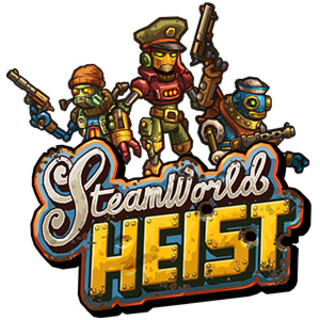INTRO:
SteamWorld is best described as a franchise IP. Few of the entries in this IP have gameplay that is similar to the others. SteamWorld Dig, one of the more commercially successful ones, does have a sequel. The others do not.
The developer, Image & Form, does not intend to build on what has been done before – or to be more cynical, squeeze more out of their proven cash-cows. This meant that the developer is free to pursue another strategy, or more likely, their games did well enough that they do not have to crank out sequels.
SteamWorld Heist is Image & Form’s next foray into gameplay that is different from those in their previous games.
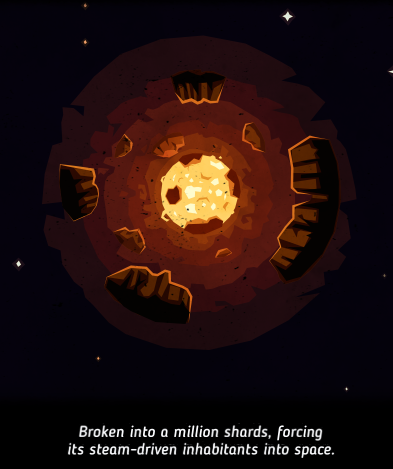
PREMISE:
The game appears to take place in the same setting as the other SteamWorld games, though with one glaring exception: there is no intact “world” in which the story takes place on.
Rather, the world that is explicitly mentioned in the story has been shattered – and it is, or rather was, none other than “Earth”. The developers, in one of their pre-release videos, have mentioned that the game takes place long after Dig and Tower Defense. (There will be implied references to Dig and Tower Defense late into the story, though to elaborate more would be to mention spoilers.)
Anyway, sapient robots were the only known population of Earth. Among them, Steam-Bots are the most numerous. Steam-Bots can use almost any kind of fuel to generate steam from water, but ever since the rupturing of Earth, water has been a precious commodity. Indeed, it is precious enough such that it is used as a form of currency.
The Steam-Bots have since spread out into the stars. It is not clear how far they went, but it is not likely to be far because many establishments happen to be built on fragments of Earth. Not having to breathe certainly makes such feats possible. Proud of their ability to adapt, these Steam-Bots have since called themselves the “Cow-Bots”.
However, where the Steam-Bots have moved on, other robots have not. The Royalists remember how Earth was, and retains much of the technology that has been developed prior to its fracturing. They gather relics of the Earth and are trying to restore Earth by linking its fragments together.
Such goals would have been noble, if not for the means for how they do so. Claiming authority over everything and everyone who was once part of Earth, the Royalists wrest much from the Cow-Bots, threatening them with their superior technology to gain compliance.
Such woes would have been bearable, but things have gotten worse. A faction called the “Scrappers” have arisen. These are ramshackle robots, driven to scrap anything and everything, including other robots, to raise an army of angry malcontents. Meanwhile, there are worries that the Royalists would have a very heavy-handed response to this uprising, considering that the Royalists have become more arrogant and aggressive in recent years.
Things would only get worse from there, after the source of the Scrappers’ power is discovered. An ancient enemy of robots with free will returns to pursue what it has been made to do.
THE PLAYER CHARACTERS:
Thus, the player characters enter the scene. The main protagonist is “Captain” Piper Faraday, an outlaw with a past of regrets. She is the commander of a vessel piloted by Wonky, the only crewmember on-board that is involved in her past. The other crewmembers are vagabonds, rogues and other disaffected robots that she has hired, but a mission gone bad in the prologue has reduced them to just one functional member, a tough but grumpy former whaler by the name of Seabrass.
Not that she and Wonky are broken-hearted over this setback. Piper is an accommodating leader with an easy charisma that does not make it difficult for her to replenish her crew.
Indeed, such would be the premise for the recruitment of the other player characters, who are down-and-out, coming out of retirement or just yearning for adventure. Piper would take them all in, regardless of the risks that would arise from their proverbial baggage or hidden agendas, or Piper’s own for that matter.
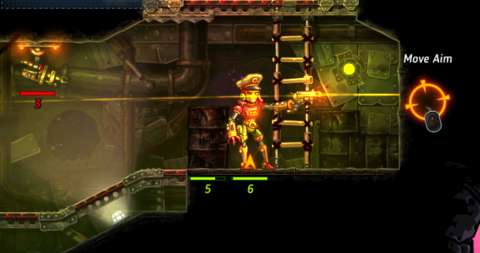
But then, SteamWorld’s developers had never been known for writing deep and complex stories. Their characters are serviceably interesting enough for inclusion in video games, but not particularly memorable because their designs are checkbox ticks on character tropes, albeit with the twist that they are all steampunk robots. The same can be said about the characters in this game.
Further reinforcing the impression that they are checkbox-ticked characters, many of them follow well-worn archetypes. For example, Seabrass is a hard-bitten grump, whose abilities draw from his gruff stubbornness. For another example, there is a strong-man that happens to have a Russian name and who is pumping an iron bell almost all the time.
If anything, the characters are entertaining for how the artists have converted otherwise-human characters into robots. They are not any more valuable than other kinds of conversions, such as the anthropomorphizing of animals.
KITTING OUT PLAYER CHARACTERS:
The meta-game of the gameplay is the loud-outs of characters. Any player character only has a few slots for items that they can take into a mission, but each slot has many alternatives. Most of the long-term elements in the gameplay are about gathering the items that would go into these slots.
This is not just about looking for the straight upgrades for the previous ‘marks’ or lesser versions of a line of items, though the player will be doing this anyway. There are ‘side-grades’, i.e. items with similar overarching functions but noticeable differences in how they carry out these functions. For example, there are guns with laser sights, but there are variants of these: one variant can be fired after moving, and another is more powerful, but can only be fired without having moved.
Ultimately though, damage output is the highest priority, if only to remove threats as quickly as possible.
INVENTORY:
Gameplay about load-outs indubitably involves some kind of inventory that the player would draw items from. Some games do not place a limit on the size of the inventory, which makes acquisition of items a simple matter though at the cost of having to implement filters and sorting features to allay tedium of organization.
Some other games do not, mainly because their developers believe that inventory management makes for sophisticated gameplay. For better or worse, Heist is one such game.
Presumably, with the excuse being that Piper’s ship cannot hold so much stuff, the player’s inventory is limited to just several items initially. To increase the size of the inventory, the player has to earn enough water to purchase additional capacity for the inventory (never mind how these are installed into Piper’s ship). Repeating missions to gain the Water that is needed to buy inventory expansions can be unpleasant.
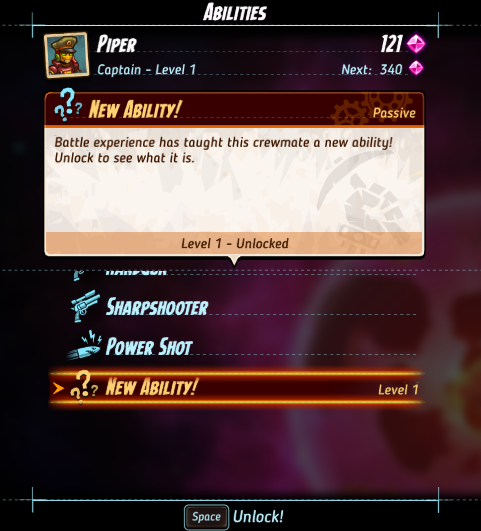
WATER:
The player has the crew going on missions to gather the aforementioned currency of this version of the SteamWorld universe: water. Water is used to purchase items for inclusion in the player’s inventory. Some player characters would only join after paying a recruitment fee in water. Water is paid as the penalty for aborting or failing missions. There are no other uses for water though.
The implementation of the preciousness of water in the story is not entirely convincing either. For one, the Royalists now drill for oil instead of farming for water, but they still use water for applications that are not clear. An esoteric faction that is revealed later also has water among their possessions, but what they do with it is not clear and can only be implied.
GUN RESTRICTIONS:
Despite being robots and having hands that can handle guns, not every robot is able to use every gun. Some had the training and temperament to use certain guns, while some have the body build to handle heavy weapons that would otherwise damage other robots with their recoil. Thus, every player character has restrictions on the guns that he/she can use. (The robots have clearly typified themselves as having genders, by the way.)
Almost every player character can use handguns, which are the most ubiquitous of weapons. Next, he/she is able to use one other type of gun, usually a type that meshes with their personality and training. For example, Piper is known for being a good shot, so she can use “sharpshooter guns”, which are handguns fitted with scopes and laser sights.
However, no matter the guns that the player characters can use, each of them can only use a single gun.
TOOLS:
In addition to their guns, the player characters can equip two additional items. These items grant them abilities that they do not intrinsically have. For example, the shrapnel grenade lets a player character execute an area effect attack. However, these items usually can only be used once, though some can be used more often. Generally, they cannot be replenished during a mission.
HATS:
Heist was developed during a time when having player characters sporting all kinds of hats is a trend, thanks/no thanks to Team Fortress 2’s entertainingly ridiculous and high-profile re-branding as a “hat simulator”.
Each player character comes with a hat that he/she has by default, such as the officer’s hat that Piper has. Some hats are also sold in certain shops for ridiculous amounts of water.
Enemies also wear hats, no matter how deranged they are, so hats can be stolen from them too. If they do not have hats, then parts of their head can be knocked off to be worn as hats.
Again, Team Fortress 2 is the one to blame for this inanity.
Collecting hats from enemies involves either blowing up their bodies but otherwise leaving their heads intact, or shooting off their hats (or parts of their head) before blowing them up. The latter option might not be time-efficient though. Either way, hats have to be collected like any other loot, so there are always risks to collection of hats during missions while being pursued by angry enemy robots.
Ultimately though, hats do not impart any gameplay-affecting changes. Even the portraits of the player characters would not change when they change their hats.
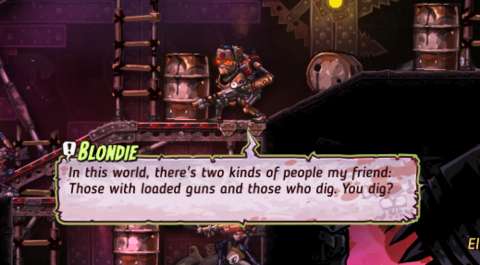
ACTION SYSTEM:
Heist is one of those games that use the action system that has been seen in the XCOM reboots and a number of other turn-based games since. (It should also be noted here that this system has been in some pen-and-paper RPGs too.)
To elaborate, each character has two “half-actions”. The first half-action can be used to move about. The second half-action can be used to move around some more, but cannot be used to open doors or hatches that lead into unrevealed rooms (more on these later). Either half-action can be used to fire the character’s gun, make a melee attack or use a tool item, but this generally ends the character’s turn.
At least one of the player characters have abilities that circumvent these rules. There are also items that go around these rules, like sidearms that can be fired without ending the player character’s turn (unless the player character has spent both half-actions).
Indeed, making use of things that work around the rules on using half-actions will be one of the means to defeat numerically superior enemies.
TRAVELLING:
The player’s ship is represented in the screen that is used for travelling from one location to another. Each location is represented as a node in this screen. Each node is connected to at least one other node, if only so that any node can be reached. Going from one node to another does not require the expenditure of any fuel.
Every node has a tooltip that shows the significance of the location to the story or the gameplay. In the case of locations that are missions, the player can examine the objects and the descriptions of the missions prior to attempting them. In particular, some descriptions contain tips about how best the player should approach the missions; usually, these tips are relevant.
Not all nodes are available from the start. Some are locked behind other nodes, which have to be dealt with first. These obstacle nodes can be one of two kinds: it may be a node that is about a mission that has to be completed in order to progress, or a node that requires the player to achieve a specific level of “reputation”.
REPUTATION:
In the narrative, “Reputation” is – of course – the reputation of Piper’s band in the current region of space. As the player completes missions and collects epic “swag” (more on this later), they gain Reputation points. These are needed in order to progress in the game, and to recruit certain player characters who want to be associated with a formidable band of fighters.
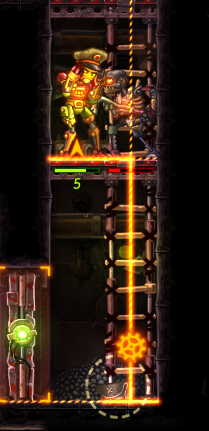
CAPERS & RUNS:
Being a band of vagabonds, Piper’s company has to frequently partake in acts of piracy in order to build a reputation and to supply themselves with better gear. Conveniently, most of whom that they prey upon are those who would not be missed, so the player does not need to be concerned about the morality of what they are doing.
Anyway, the missions that they go on involve raids on ships that are operated by the opposing side. How Piper’s ship is able to sneak up on these ships to plant a boarding party without get shot up can seem unbelievable, but it would quickly become obvious that the space-ships in Heist are not armed. Any offensive operations carried out with ships will involve boarding parties.
Eventually, it is revealed that Piper’s company has the policy of not risking her ship to counter-boarding. This means that the band’s chosen boarding party are left on their own.
This is a convenient excuse for not being able to call upon the rest of the crew as reinforcements. What is not so conveniently explained away is why the player can only bring a limited number of player characters into the mission, instead of flooding the enemy ship with every capable fighter. Indeed, missions where the player can only bring a single player character have descriptions that imply that the excuses for this restriction are either frivolous or hand-waved away.
Of course, from the perspective of gameplay balance, having every player character board the enemy ship would have made things rather easy. Each player character is quite powerful at any difficulty setting below the highest one. Each additional player character would contribute more to the player’s efforts than the sum of the capabilities of all player characters. In the case of Piper’s inclusion in the boarding team, this is not an exaggeration; she has abilities that can buff team-mates.
ENEMY REINFORCEMENTS:
The player’s team is cut off from reinforcements, but the enemy is not, at least in missions where they get reinforcements.
Whether as part of scripted events or a state of alert (more on this later), enemies may enter the scene through bulkhead doors that are in the background. Presumably, these came from other parts of the ship that are not shown in the mission area, but there are some scenarios where they are simply spawned from somewhere or something else.
Whatever the means, there is little that the player can do. For ones, the doors cannot be jammed. There are few means to lock them down either; few, if any, of the player characters can lay down turrets or mines to ambush the incoming reinforcements.
Most importantly, the player does not gain anything from defeating the reinforcements. As the rounds go by, the reinforcements only get nastier and more numerous.
Therefore, it is not in the player’s interest to linger for too long in missions with reinforcements. Indeed, an in-game tip even mentions that there is little reward from killing enemies (unless the player wants their hats, if they have not been obtained already).
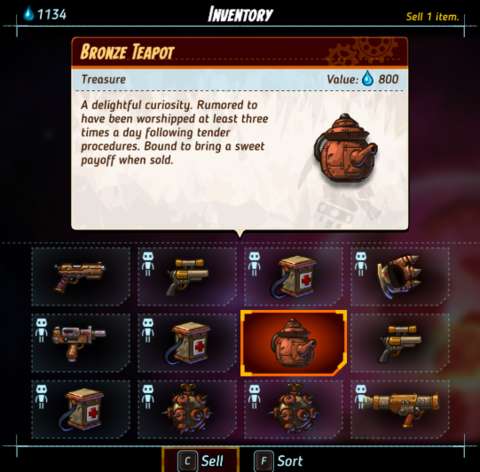
STATE OF ALERT:
In missions where enemy reinforcements are included, there is a system for the state of alert among the enemy. This state of alert is indicated by a series of icons in the top right of the screen.
One of these icons indicates the activation of turrets. Generally, the turret pods are already visible from the onset of the mission; they even appear in the map display. However, they cannot be harmed until after they have popped out. Turrets do not all become active immediately too; instead, random ones are activated, until all of them are.
Turrets are relatively easy to destroy. Some of them may also be too far away to be a threat.
The other type of icon is depicted by skulls. The number of skull indicates the number, frequency and quality of enemies that would arrive as reinforcements.
Most missions with states of alert implemented do not start with all states of alert activated. A countdown timer shows the number of rounds to the activation of the next icon.
There are some missions that use the timer for something else. For example, there are scenarios where the enemy ship would self-destruct or completely seal itself. In these missions, there are usually some means of adding to the timer.
PROCEDURAL GENERATION OF MISSION AREAS:
Prior to the start of a mission, the game generates the interior of the mission area. However, the exterior silhouette of the mission area is always the same for a specific mission. The room layouts and connections may be different from one attempt to another, however.
Nevertheless, knowing the exterior silhouette of the mission area goes a long way in helping the player succeed at another attempt at the mission. For example, in certain missions, the player characters must reach certain segments of the ship, which are always in certain parts within the silhouettes of the mission areas.
FOG OF WAR:
The interior of mission areas always begin as visually obscured, with the exception of the starting room. Some player characters have abilities that reveal the locations of loot in the fog of war, which help a lot in deciding where to go next.
Enemies are not affected by the fog of war; if they have been activated and know where the player characters are, they will move through the fog and even open doors to get to the player characters. However, most enemies will remain where they are and only become activated after the fog of war in their room has been removed.
Speaking of which, the fog in a room is removed by having a player character open a door that leads into the room. If the door is already opened (usually due to enemy action), a player character must have a clear line of fire into the room in order for the fog to be removed.
However, it is still possible to ricochet shots or bounce grenades into an obscured room to harm anything that may be in it.
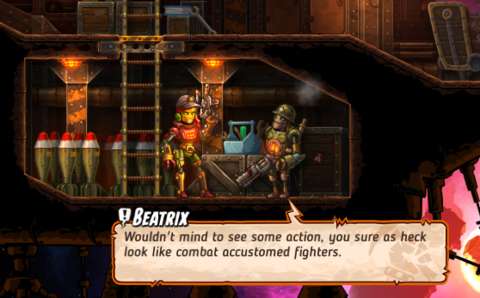
DOORS:
Some doors are set perpendicular to the screen; players who are experienced in games with 2D environments with verticality would recognize these almost immediately.
Characters can open these readily, unless they happen to be locked for whatever reason; the locked ones are usually indicated with red lights.
Opening doors can be done in one of two ways, depending on whether the rooms that they lead into have had their fogs lifted or not. If they are not lifted, the doors have to be opened by having player characters directly interact with them. If the doors happen to be at the end of the maximum distance that can be travelled with one half-action, that half-action is spent. Otherwise, the player character has some of that half-action remaining in order to move further, or do some other thing.
Doors cannot be opened if the player character has only one half-action left, however (for whatever reason). If a player character has already opened a door earlier, he/she cannot open any other door even if he/she has both half-actions remaining.
If the fog has been lifted from a room, a door into the room will be opened if a player character has been given a movement path through it. This can happen even if the player character has just one half-action left.
The above-mentioned limitations on the opening of doors are not well-communicated to the player, unfortunately. This can be a nagging problem to players who are meticulous planners.
EXTRACTION:
After achieving the mission objectives, the exit area will be revealed. This is usually the region around one of the bulkhead doors in the background. The bulkhead door also ceases to be a spawning point for enemy reinforcements.
The player must have the player characters reach this region, and end their turn there, or spend their second half-action reaching it. However, at least one of the player characters must have one half-action remaining, because the presence of this remaining half-action is the condition for a prompt to appear. This limitation is not well-communicated to the player.
Anyway, the prompt is about the player’s decision to extract; he/she is also shown the percentage of loot that has been recovered. (There will be more on loot later.)
The player must make the decision at this point; if the player chooses to delay the extraction, the next extraction attempt can only be done at the end of the player characters’ next turn. The delay can be costly, especially if the player characters are being hounded by enemy reinforcements.
LINES OF FIRE AND WAVERING:
Most turn-based tactical combat titles resolve shooting with RNG rolls, which are unpleasant and often unbelievable. However, the alternative is to somehow draw a line of fire from the shooter to the target – something that is not easy to do automatically with scripting.
On the other hand, games like the Valkyria Chronicles series have shown that it is possible to do so by simply placing it in the player’s control – something that is very much welcome in the eyes of players who prefer having more say in the pacing of the gameplay.
Yet, games like Valkyria Chronicles can pose some challenge to the player, namely which part of the enemy to shoot in order to maximize damage output. This is not so easy to do when the environments are 3D and the target has body parts that may obscure their weak spots.
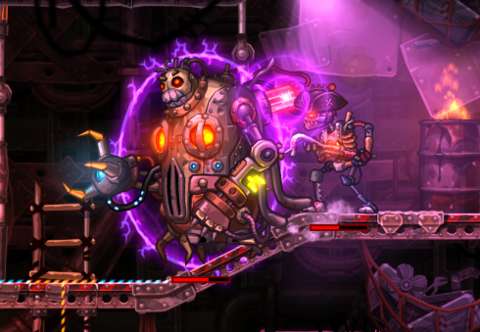
In a game with 2D environs like Heist, drawing a line of fire would seem like child’s play, since the player’s perspective is much simpler than that in a 3D one. Therefore, for better or worse, the developers have decided to inject additional difficulty in the act of drawing a line of fire from a player character to the target: the robots waver in their aim.
This wavering can seem annoying to players that do not like gameplay factors that are not about prudent decision-making. This can seem like a variant of the implementation of reflex-based mini-games in old-school JRPGs, specifically the infamous one where the player needs to land a cursor in specific regions within a meter.
Fortunately, the player can choose to opt out of the aiming at any time, and delay that until later. However, there are few ways to steady the robots’ aim, which is a limitation that can seem unbelievable, at times. They are robots, after all.
DRAWING TARGETS:
The player can have a player character take aim by pressing a button. By default, the player character aims to the left or right of his/her sprite, depending on the direction that he/she is already facing.
Obviously, this is not a great way to aim, especially for a computer game. Fortunately, the player can use the mouse to aid in the aiming. Clicking on a piece of cover or an enemy creates an icon of a target on that object, centred exactly at where the player clicked.
The player character then aims at the general direction of the target, though the wavering continues. Observant players may notice that the player character will always aim exactly at the centre of the target just before the wavering begins, so players with quick fingers may attempt to immediately fire as soon as the target has been drawn.
ANGLE OF FIRE:
When the player character aims, the player can control his/her angle of fire in a vertical 180-degree arc. This can have the player character aiming away from any drawn target that the player has set, however; the target will not be re-drawn automatically.
If the player makes a second click within the drawn target without having it redrawn, the player character will fire in the direction that he/she is currently aiming at, and not at the drawn target. This is something that is not communicated well to the player.
TRAJECTORY LINES:
Some guns will create trajectory lines out of them, showing exactly where the projectiles would go. Sharpshooter guns show the lines that the bullets will follow, including even their trajectories when they ricochet off surfaces; there will be more on this later.
Grenade launchers create faint arcs, though these arcs are drawn too short for effective use of these guns. This limitation is all the more noticeable when one considers that the use of hand grenades and one-use rockets comes with completely drawn trajectories and even area of effect.
Of course, there is the argument that the one-use items benefit greatly from the visual aids, whereas the grenade launchers (and rocket launchers) would have been overpowered if they have the same visual aids.
Yet, those guns could have had those visual aids, if only to avoid incidents of friendly fire. That said, all explosive weapons have risks of friendly fire; their explosions can harm team-mates. Curiously though, they can pass through team-mates.

RICOCHETING ROUNDS:
Certain guns, especially sharpshooters, fire rounds that can ricochet all over the place. The ricocheting does not reduce the damage that the rounds can inflict, but the rounds can only travel a certain distance (including any rebounds) before they are destroyed upon hitting the next surface.
Only sharpshooters show the trajectories of the ricochets, but any handgun and certain guns can have their rounds ricochet. Experienced players eventually learn how to judge ricochets through observation of the angles of the surfaces that the rounds may strike.
PIERCING SHOTS:
A certain player character and some guns can fire shots that go through multiple enemies. Veterans of video games may find these familiar. However, the caveat here is that these shots cannot go through pieces of cover.
In the case of sharpshooters, the player is shown the trajectory of the rounds, including any characters that they would penetrate through. These rounds can ricochet and pierce through any enemies afterwards too; executing such a shot can be very satisfying.
BOUNCING GRENADES:
Grenades can skip across horizontal surfaces, bounce off vertical surfaces, and, of course, fall in a parabolic arc. Thus, the physics for them can be a bit unpredictable. For better or worse, as mentioned earlier, only hand grenades have their trajectories drawn for the player to see.
Grenades that are fired from grenade launchers do not have this convenience. It would not be surprising for players to eventually switch over to rocket launchers for use as explosive fire support, if only because the latter’s rockets follow predictable paths.
COVER:
All mission areas have pieces of cover. Many of these are representative of the people who inhabit the ship or facility that the mission takes place in. For example, Scrapper junk-ships have empty barrels and concrete blocks lying about, as befitting their lackadaisical attitude to organizing things.
For another example, Royalist ships have alloy panels that pop up whenever any character moves next to them. Alternatively, a character can stand on top of them to prevent their deployment, though there are few reasons to do so.
If a character is right next to a piece of cover, the character’s line of fire ignores it, i.e. any shot that the character fires passes through the piece of cover. This means that a character can saunter up to a piece of cover that an enemy is using and shoot him/her/it at point blank.
All pieces of cover can eventually be destroyed. Some are more fragile than others. All of them can catch stray shots, meaning that any protracted fight will eventually have all cover being removed.
There are also certain enemies that can thrash pieces of cover, specifically enemies that are oriented towards melee combat.
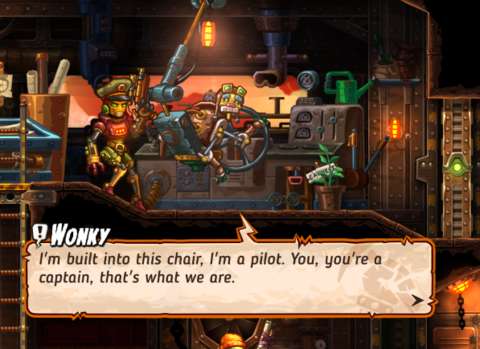
EXPLOSIVE BARRELS:
Barrels that explode when shot at have been such a fixture in video game history. Heist honours this amusingly absurd trope by having such barrels scattered around mission areas.
Interestingly, most enemies are aware enough of the barrels that they will not end their turns near them. That is, unless they want to get a clear shot at the player characters. It is amusing to tempt them to make this mistake.
OIL:
The current Royalists are not the original ones; their regime frequently experiences coups. The current generation are diesel-powered robots, who consider themselves above their predecessors, the Steam-bots.
However, they have merely switched their dependency over from water to oil. Oil barrels are a frequent sight in their supply ships, and oil spills are similarly common. Indeed, quite a number of Royalist ships have leaking oil pipes, despite their primness. The diesel-powered Royalist robots also will spill oil when they are slain.
Released oil wet horizontal surfaces. The robots themselves cannot be drenched in oil, however, which is perhaps a blessing.
Any surface that is covered in oil can be shot at to ignite the oil; the oil somehow explodes, harming anything that is on the surface or close to it. As long as an oil slick is contiguous, it will ignite, regardless of how far it stretches away from the point of ignition.
Enemies are not particularly aware of the presence of oil slicks, so the player could attempt to lure them over onto the slicks before igniting them.
SWAG:
One of the player’s objectives in any mission is the collection of “swag”. Presumably, these are valuable stuff that the enemy has; all of them are conspicuously packed away in sacks. This presentation is silly, but it makes the loot easy to spot.
That said, collecting them is as easy as having a player character spend a half-action to end a move on top of them. Spending half-actions to grab swag while harming enemies can be an entertaining experience.
The swag sacks yield loot of varying rarity; the player will not know about this when he/she collects them during a mission. Regular swag sacks always yield water, while rarer sacks yield equipment.
One of the swags is the “Epic Swag”. Conveniently, it always appears as a chest with a big star on it, regardless of the nature of the mission area. Collection of the chest is required for one of the Reputation stars to be earned from completion of a mission.
When an Epic Swag is collected for the first time, it always yield a piece of equipment, usually of considerable rarity. However, if the mission is attempted again, the Epic Swag yields nothing, but has to be collected anyway to earn a Reputation star.
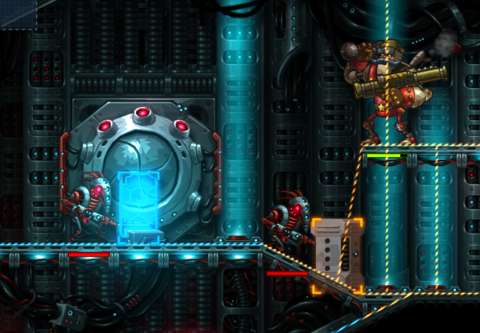
ENEMIES – OVERVIEW:
Heist is a turn-based tactical combat title, so expectedly, there would be enemies to defeat or be defeated by. The enemies will always outnumber the player characters and in missions with reinforcements, they will always be replaced.
The enemies that the player would face are generally endemic to the mission areas that the player characters would go. Barring scripted sequences, the player would only face these enemies, so the player could have a plan going into any mission that is oriented around dealing with a specific set of enemies.
Generally, enemies do not inflict enough damage to outright eliminate any player character, except maybe on the highest difficulty setting. Conversely, assuming that the player has been updating their equipment, most of the guns that are available to the player characters can inflict enough damage to eliminate any enemy in a few attacks.
Even so, this disparity is there so that the player can have something to balance against the numerical superiority that the opposition has. In missions with escalating danger, the player would eventually face powerful and tough enemies, such as the surprisingly mobile heavies that the Royalists field.
ENEMIES ARE VERY BAD SHOTS:
When enemies take shots, there is a possibility that their aim is off by a degree or two. This is meant to compensate for them being CPU-controlled.
In practice though, one degree or two can be a lot, especially considering that there can be obstacles in the way. The player may experience occasions when a grenade-launching enemy launches a grenade only to have it bounce right back on himself, or when a bullet that an enemy fired ricochets off a surface to hit a fuel barrel that is behind him.
Changing the difficulty settings will not improve the skill of enemies.
However, there are some enemies that have been scripted with incredible skill at shooting. For example, the Royalist General can ricochet his shot off so many surfaces before landing on a player character that is not within his line of sight.
TYPICAL ENEMY ARCHETYPES:
Heist tries to diversify the enemies by giving them characteristics that are unique to their type of automaton. For example, the Royalist diesel-bots leak diesel when they are slain, and Voltbots have capabilities that grant them advantageous mobility.
Eventually though, observant players would notice that enemies generally fall into several common archetypes.
There is the “grunt”, which totes a gun around and has middling durability, but very few features other than what their robot type gave them. Then, there are the bombers, who run up to the player characters to attack them in close combat, daring the player to kill them and cause them to explode. Next, there are the heavies, which are hulking enemies that can take a lot of damage and inflict just as much in return.
Players would eventually learn how best to deal with these archetypes. For example, gunning down the bombers before they reach the player characters is a prudent thing to do. Of course, this is easier said than done, due to the opportunity cost of not dealing with other threats, which can be a worse problem than kamikaze robots.
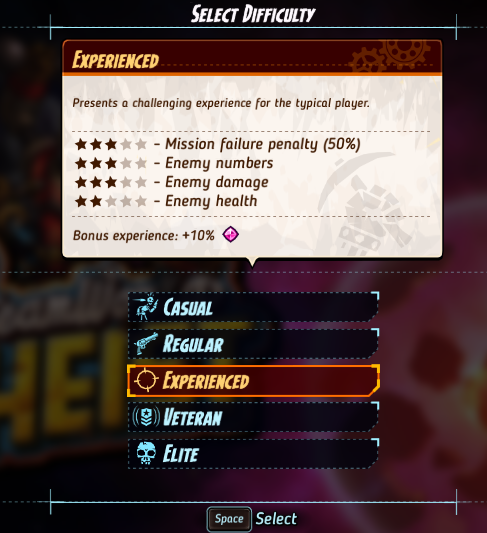
DEMISE OF PLAYER CHARACTERS:
If player characters are slain during a mission, they are not permanently dead. However, the player is heavily penalized for this setback. For each player character that is slain, the player’s water reserves are halved, and subsequently halved again for each death.
This is a startlingly significant penalty, and very unpleasant to learn the first time around. Furthermore, each death takes away one star of Reputation that could have been earned from a mission. Therefore, players with completionist streaks would have to replay missions until a sterling performance has been achieved.
Granted, many things in the gameplay are still well within the player’s control, and there are few RNGs that can be blamed for when things turn dire. Enemies may appear in any of the spawn locations, but the spawn locations are always shown to the player and enemies cannot attack in the same round that they spawn in.
EXPERIENCE GAINS & LEVELLING UP:
Heist follows the usual and typical method of character progression: experience gains and level-ups.
The successful completion of missions and the survival of player characters are the requirements for the acquisition of any experience. This is a limitation that is understandably intended for the sake of challenge. How the experience points are awarded is not as satisfying though.
Any experience from a mission is divvied equally among the player characters that participated in the mission, regardless of their performance. Any player character that did not survive will not get any, and their share is not re-distributed to the others either; it is simply lost.
When a player character gains levels, he/she gains a special ability. This ability is already decided according to the scripted progression sequence that has been made for that character.
In other words, the player has next to no options for customizing a character. The game tries to raise the fanfare of a level gain by hiding that special ability until the player clicks on it to reveal it, but this is just a cosmetic design.
VISUAL DESIGNS:
Following the previous entries in the SteamWorld franchise, all of the characters are clearly humanoid robots. However, a number of them sport parts that break up their humanoid form, such as tank treads and wheels, thus reminding the player that they are robots and not just anthropomorphized machines.
Perhaps the most notable difference that Heist has compared to the previous entries is that most of the characters have bodily proportions that are closer to that of the human form. (This would be continued in 2019’s Quest.)
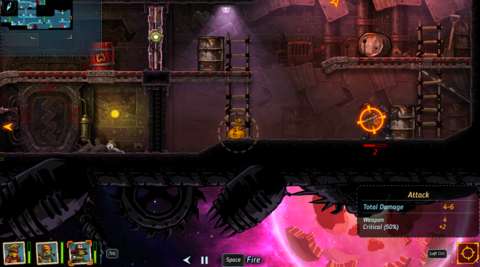
Most of the Steam-bots have outlets that are belching out steam, though some characters that consider themselves to be Steam-bots appear to be missing these (most notably Piper).
Robots that specifically identify themselves as belonging to a faction have visual designs that make them immediately recognizable. To cite some examples, the ramshackle looks of the Scrappers fit their origins, and the Royalist robots favour gold and red paint-jobs.
The environments of the mission areas are designed for association with the hostile robots that are endemic to these locations. This means that there are only as much variety as there are factions of enemies.
Heist might be showing its age, or rather the limitations of its artists. Sprite mirroring is a common occurrence throughout the game, something that is made all too noticeable because most robots have asymmetric designs. Furthermore, when a character uses any tool item, the same sprite is used for that character regardless of the tool that is used.
Then, there are some design decisions that bring to question where the priorities of the artist lie. For one, there is gratuitous slow-mo when characters are slain or when hats are shot off. Characters emit speech bubbles when these occurrences happen, but the camera pans a lot during these moments, making it hard to see the speech bubbles. Particle effects emit from slain characters, thus obscuring the breaking up of their sprites as the robots are forcibly disassembled.
SOUND DESIGNS:
Like the previous entries in the SteamWorld franchise, there is no legible voice-acting whatsoever for the characters. Only the narrator of the cutscenes actually talks in English.
All robots talk in warbles and whirrs, yet somehow understand each other perfectly. Of course, for the sake of the player, their dialogue and monologue are presented with text bubbles.
However, the paucity of voice-over assets is apparent in this one. There are a lot of characters in the game, so the reuse of voice-over assets will become noticeable eventually.
Like Dig, the music in this game has been composed by European artistes who have somewhat of an inkling about how USA country music sounds like. The resulting tracks are similar to those in Dig, except with the addition of lyrics. The addition is not exactly a convincing improvement, however; most of the lyrics had been written like a narration of plot turns in the story, so they would only make sense to people who have played the game.
There are bands in the bars and pubs that Piper would visit. Conveniently, the presence of these bands is the excuse for playing these tracks.
The other tracks are serviceable and adequately appropriate for the ambience of the missions. However, they would not be particularly memorable to players that have already heard a lot of music from indie bands and composers.
The best sounds in the game are those from the firing of guns. Many of them sound satisfying, especially if they connect with enemies. On the other hand, the sounds of the guns and explosions would not be anything new to players that have already played many video games with guns in them.
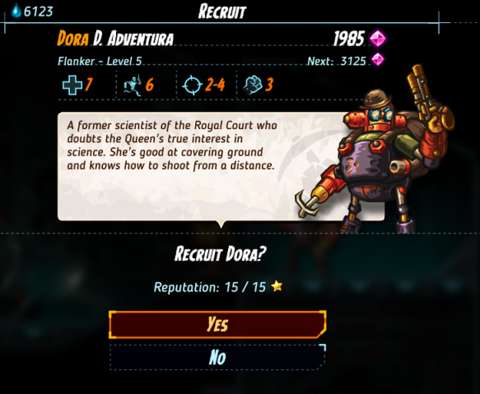
SUMMARY:
Heist is yet another foray by developer Image & Form into gameplay that they are not particularly familiar with, just like the previous entries in SteamWorld were. Like the previous entries, they are not astoundingly impressive, but are sophisticated enough to be convincing expressions of the skill of the developer at designing different kinds of gameplay.
Perhaps the only reason to ever spend time and money on this game is to hope that this would somehow nurture the indie developer, such that its people would eventually gain the skill and experience to make its greatest work. That said, this otherwise competently-done game is not Image & Form’s magnum opus.
